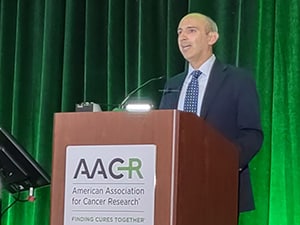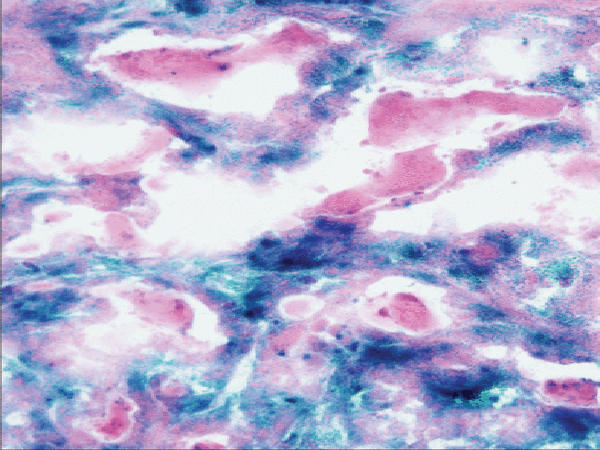Pancreatic Cancer: The Search for an Achilles Heel
Pancreatic cancer seems to have a defense against every attack researchers throw its way.
It rarely causes symptoms and arises in a hard-to-access organ, complicating prevention and screening efforts. Only around 20% of pancreatic cancers can be removed by surgery. A dense tumor microenvironment makes it difficult for immune cells and even some therapies to infiltrate. Chemotherapy is among the few effective therapies, but it rarely works long term. With a five-year relative survival rate of 12.8% in the United States, pancreatic cancer can seem downright invincible.
But even the seemingly invulnerable Achilles had a weak spot, and pancreatic cancer researchers continue to search for similar weaknesses in this deadly disease. The ongoing hunt for new targets formed a major theme of the keynote addresses of the AACR Special Conference in Cancer Research: Advances in Pancreatic Cancer Research, held in Boston September 15-18. Both the keynote lecture, presented by Eileen O’Reilly, MD, and the rising star keynote, presented by Joseph Mancias, MD, PhD, highlighted how investigating pancreatic cancer’s greatest strengths may help uncover its most critical vulnerabilities.
Old Problems, New Solutions
While new combinations, schedules, or doses of chemotherapy have only provided incremental improvements in patient outcomes in recent years, advances in targeted therapy have spurred more substantial progress, explained O’Reilly, the Winthrop Rockefeller Endowed Chair of Medical Oncology, chair of the Human Research Protection Program and Institutional Review Board, and co-director of Medical Initiatives in the David M. Rubenstein Center for Pancreatic Cancer Research at Memorial Sloan Kettering Cancer Institute.

“Pancreas cancer … is still a disease that’s primarily treated with chemotherapy,” she said. “But that is changing, and I think it’s likely that we’re going to see new targeted agents populate the scene in the coming couple of years—hopefully sooner rather than later.”
She discussed three areas in which researchers are making particularly promising strides.
The poly (ADP-ribose) polymerase (PARP) inhibitor olaparib (Lynparza) has been approved by the U.S. Food and Drug Administration (FDA) for the treatment of pancreatic tumors with defects in the homologous recombination (HR) DNA repair pathway, but thus far, it is only approved for patients with metastatic disease whose tumors have a mutation in the BRCA1 or BRCA2 gene. Researchers have been investigating how to broaden the available treatment options for these patients and serve patients with HR deficiencies beyond BRCA.
In a phase II clinical trial, O’Reilly and colleagues tested the investigational PARP inhibitor veliparib, in patients with pancreatic ductal adenocarcinoma (PDAC) harboring a mutation in BRCA1, BRCA2, or PALB2. While veliparib did not improve progression-free or overall survival, it did trend toward improved response rates. O’Reilly also mentioned promising evidence for better outcomes when patients were treated with platinum before veliparib instead of simultaneously.
In another trial, researchers tested olaparib plus the immune checkpoint inhibitor (ICI) pembrolizumab (Keytruda) in three distinct cohorts of patients with pancreatic cancer: those with BRCA1 or BRCA2 mutations, those with other mutations in the HR pathway, and those who had previously responded well to platinum-based chemotherapy, which has historically correlated with improved response to PARP inhibitors. Patients harboring BRCA mutations had favorable responses, as expected, and the data suggested that the combination may serve as an effective maintenance regimen in patients with other HR mutations or established sensitivity to platinum.
O’Reilly also addressed new advances in targeting tumors driven by mutations in a different DNA repair pathway, the mismatch repair pathway. Mismatch repair mutations can be either inherited (causing a disease known as Lynch syndrome) or develop during tumor formation. In either case, the disrupted pathway can spur a type of DNA damage known as microsatellite instability, which can make tumors susceptible to ICIs.
In a recent retrospective analysis of 20 patients with mismatch repair-deficient pancreatic cancer who received ICI therapy, the disease control rate was 80%, and patients remained on treatment for a median of 27.7 months. However, the researchers stressed the need for better ways to assess microsatellite instability in pancreatic tumors, from which it is difficult to harvest robust samples. They developed an artificial intelligence classifier to more closely investigate samples with low cellularity and successfully reclassified six of the 20 tested patients based on the results, a finding they’d like to expand on.
Another promising target is KRAS signaling, with plenty of activity spurred by recent breakthroughs in KRAS inhibitors. Currently, FDA-approved inhibitors only exist for one KRAS mutation, G12C, which is prevalent in lung and colorectal cancer but only accounts for 1% of all pancreatic cancers. Nevertheless, KRASG12C inhibitors have prolonged survival for more than six months in patients with such mutations, including Humberto M. Guiot, MD, a patient featured in the AACR Cancer Progress Report 2024 who entered complete remission after treatment with the KRASG12C inhibitor adagrasib (Krazati). O’Reilly touted the success as an encouraging sign that KRAS inhibitors targeting other forms of the protein may be successful in pancreatic cancer.
She highlighted a few emerging KRAS therapies, including RMC-6236, which targets multiple mutant forms of KRAS and other RAS proteins in their active conformation; this differs from the approved KRASG12C inhibitors that target the inactive conformation of the protein. According to a statement released in July from the manufacturers of RMC-6236, patients with RAS-mutated pancreatic cancer enrolled in their first-in-human trial have experienced durable progression-free survival and a median overall survival that was not estimable at 12 months of follow-up.
O’Reilly also called attention to a promising vaccine for KRAS-mutated pancreatic cancer. ELI-002 was a two-peptide vaccine that, in a phase I clinical trial, demonstrated a significant decline in KRAS biomarkers and a handful of responses in patients with KRAS-mutated pancreatic and colorectal cancer. The manufacturers built off this data to develop a seven-peptide version of the vaccine that is currently being tested in a randomized phase II trial.
“I think it’s clear that we’re moving into a different era in pancreas cancer,” O’Reilly said. “There appear to be subgroups of patients where there are opportunities to treat the disease shy of chemotherapy.”
Pancreatic Cancer Cells’ Iron-rich Diet
While O’Reilly focused on how cells’ genetic drivers give researchers clues about what makes them vulnerable, other researchers have explored peculiar behaviors of pancreatic cancer cells. Mancias, an assistant professor of radiation oncology at Dana-Farber Cancer Institute, studies how cancer cells use a particular kind of “cell eating” called autophagy, in which the cell recycles some of its intracellular components.

In autophagy, a membrane called a phagophore forms inside the cell and encapsulates structures such as organelles, ribosomes, and protein aggregates. The resulting autophagosome then merges with a lysosome, which triggers the degradation of the structures, and useful components are exported back into the cytoplasm.
Mancias explained that autophagy is more common in PDAC cells than those of other cancer types, which may present a therapeutic vulnerability. Thus far, the only well characterized autophagy inhibitor is hydroxychloroquine, which blocks the degradation of cargo within lysosomes. So far, clinical trials of hydroxychloroquine haven’t shown any benefit to overall survival, Mancias said. But instead of encouraging him to give up on autophagy as a therapeutic target, these data spurred him to take a closer look.
“So I think—and many people think in the field—that we really need to identify and evaluate the next generation of autophagy inhibitors, anticipate the mechanisms of resistance of autophagy inhibition, and reevaluate the exciting combination therapies … that have this promising preclinical data,” Mancias said.
Mancias and colleagues found that a protein called NCOA4 is strongly upregulated during autophagy in PDAC cells and that it colocalizes with ferritin, an iron storage protein. NCOA4 draws ferritin into autophagosomes so that it can be degraded to release free iron, a process called ferroptosis. The cell can then use the free iron to boost protein production and cellular metabolism.
In a paper published in Cancer Discovery, Mancias and colleagues showed that, in mouse models of pancreatic cancer, knocking out the gene for NCOA4 delayed tumor formation and improved survival, while overexpression of NCOA4 did the opposite. Tumors lacking NCOA4 compensated by increasing the expression of transferrin receptor, which pulls more iron into the cell, and decreasing the expression of ferroportin, which shuttles iron out of the cell.
Mancias stressed the need to develop new strategies for autophagy inhibition that can be used in the clinic as monotherapies or in combination with existing approaches. One drug, DCC-3116, inhibits the kinases ULK1 and ULK2, which initiate autophagy in response to cellular stress; researchers are currently enrolling for a phase I/II clinical trial of DCC-3116 plus the MEK inhibitor trametinib (Mekinist) in patients with solid tumors harboring mutations in the RAS or RAF kinases.
Why this patient population? Mancias and colleagues showed in another Cancer Discovery article that blocking the RAS signaling pathway (which includes the kinase families RAF, MEK, and ERK, all of which have FDA-approved inhibitors) also upregulates autophagy, possibly as an escape mechanism. Therefore, researchers hypothesize that concurrent inhibition of autophagy and the RAS pathway may have synergistic effects.
Another drug, ESK981, blocks a different step in the initiation of autophagy and is being currently evaluated in a phase II clinical trial for the treatment of advanced solid tumors. Further, Mancias and colleagues have been testing an inhibitor of NCOA4 that may block ferritinophagy in preclinical models.
“[Ferritinophagy] may be one of the most important cell autonomous aspects of autophagy in pancreatic cancer, and it might be worth targeting,” Mancias said. “We now understand how autophagy is being used in pancreatic cancer, and there’s promise in the targeting of autophagy with some of these next-generation inhibitors.”
Missed us in Boston? You can still register for on-demand access to the AACR Special Conference in Cancer Research: Advances in Pancreatic Cancer Research to receive video recordings of all sessions. On-demand access will be available through November 27, 2024.



